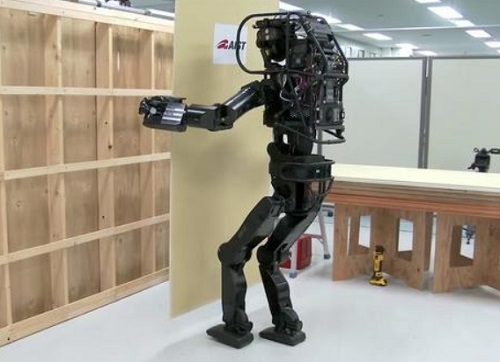
In an effort to fill labor gaps and speed up deliveries, North American warehouses are turning to automation.
A growing number of self-driving or remote-operated machines are shuttling clothing, sports equipment and electronics down warehouse aisles, pulling bins of groceries, toiletries and even industrial parts from high stacks before handing them off to human workers. All this to process and deliver orders faster.
Meanwhile, some operators are testing forklifts that can be operated from remote locations. This is allowing warehouse owners in tight labor markets to draw from a geographically broader pool of workers.
Warehouse operators turning to automation during the pandemic
The push to automate warehouses comes as many employers say that they can't hire warehouse workers fast enough to meet surging online demand for everything from frozen food to furniture in pandemic-disrupted supply chains. This situation is accelerating their adoption of robots and other technology in a sector still largely dependent on manual labor. (Related: Coronavirus lockdown leads to increase in automation as employers turn to robots to keep their businesses running.)
"This is not about taking over your job, it’s about taking care of those jobs we can’t fill,” said Kristi Montgomery, vice president of innovation, research and development for Kenco Logistics Services LLC.
The Chattanooga, Tennessee-based Kenco is rolling out a fleet of self-driving robots from Locus Robotics. These robots are now helping workers fill orders at Kenco's largest e-commerce site in Jeffersonville, Indiana.
In addition, Kenco is also using autonomous tractors that tow carts loaded with pallets.
Meanwhile, shipping giant DHL is investing $300 million in emerging automation technologies at its U.S. and Canadian distribution centers.
Much of the company's investment is going into autonomous mobile robots from Locus Robotics. It's also looking to deploy unmanned forklifts.
Adrian Kumar, global head of operations science and analytics at DHL Supply Chain, praised the technology's flexibility and ability to work within existing warehouse infrastructure.
“If you have 10 sites that are all running Locus Robotics, you could move those robots between the different sites as one site hits a peak and another hits a trough. We could lease more robots at peak season,” he said.
Kumar also stated that the company is also testing technology that can autonomously perform multiple warehouse tasks, such as unloading trucks, transporting pallets to and from the dock and to different parts of the warehouse and placing pallets into racking.
Remote control also seen as an alternative
Robots aren't the only thing warehouse owners are using to address the labor gap. Remote operation, allowing workers to control equipment from outside the warehouse, is another option companies are looking into.
Kenco has partnered with technology startup Phantom Auto to test remote-operated forklifts. These forklifts have been equipped with technology that allows drivers to operate them remotely using real-time video and audio streams.
Using the technology, operators can switch between different vehicles in different locations depending on demand. This opens up jobs to workers in regions far from the warehouses.
The technology could also let companies like Kenco access untapped sections of the label market. This includes people who are physically disabled, Montgomery said.
Labor market remains small despite growing e-commerce segment
Increased automation has traditionally come with raised fears of shrinking the labor market, with robots usually seen as taking jobs from humans. But the global pandemic and efforts to combat it have turned that dichotomy on its head.
Federal figures show that American warehousing and storage companies added nearly 168,000 jobs between April of 2020 and April of this year in response to the growth of e-commerce during the pandemic. But according to a preliminary report by the Department of Labor, sector payrolls contracted by 4,300 jobs from March to April.
May logistics employers say that they cannot hire enough staff to keep pace with strong demand as the U.S. economy emerges from the pandemic. These employers are therefore turning to automation to fill the gap.
"Robots are beginning to fill that void,” says Gartner Inc. supply-chain research vice president, Dwight Klappich. Gartner forecasts that demand for robotic systems that deliver goods to human workers will quadruple through 2023.
"We have been benefiting from that significantly since the second half of last year," says Jerome Dubois, co-founder and co-chief executive of the Shopify Inc.-owned robotics provider 6 River Systems. "The driver here is not to reduce costs, but simply to serve the customer’s needs. They simply cannot hire."
Despite the increase in automation, the demand for human labor remains high thanks to the e-commerce segment's growth.
"With all the growth we see in demand and e-commerce, we are continually looking for more and more workers while we are adding more and more robots," Ashfaque Chowdhury, president of supply chain for the Americas and Asia Pacific for XPO Logistics, says.
Historically, warehouses have simply provided a staging area to ship raw materials to factories and finished goods to retailers. But e-commerce has changed the retail side of the businesses. Now, warehouses must also sort through different items for delivery to homes and officers.
According to XPO, it takes three times as much space and effort to individually ship to consumers than it does to send goods over to a retail store. This means that warehouses will have to continue to expand their workforces, with both human workers and robots, as the e-commerce segment grows.
Follow Robotics.news for more on how e-commerce businesses are turning to automation when they can't find workers for their warehouses.
Sources include:
Please contact us for more information.





















